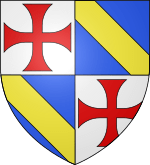Jacques de Molay facts for kids
Quick facts for kids
Jacques de Molay
|
|
|---|---|
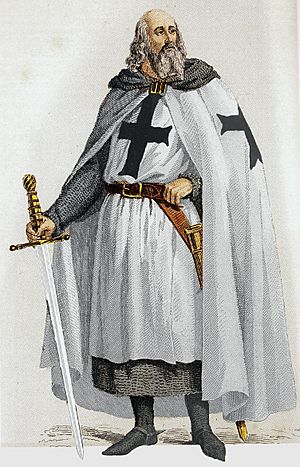 |
|
| 23rd Grand Master of the Knights Templar | |
| In office 1292–1312 |
|
| Monarch | King Philip IV |
| Preceded by | Thibaud Gaudin |
| Succeeded by | Order Disbanded |
| Personal details | |
| Born | c. 1240–1250 Molay, Haute-Saône, County of Burgundy |
| Died | 11 or 18 March 1314 (aged c. 70) Paris, France |
| Nationality | Franc-Comtois |
| Military service | |
| Allegiance | |
| Years of service | 1265–1314 |
| Rank | Grand Master (1292–1314) |
| Battles/wars | Siege of Ruad |
Jacques de Molay (French: [də mɔlɛ]; c. 1240–1250 – 11 or 18 March 1314), also spelled "Molai", was the 23rd and last grand master of the Knights Templar, leading the order sometime before 20 April 1292 until it was dissolved by order of Pope Clement V in 1312. Though little is known of his actual life and deeds except for his last years as Grand Master, he is one of the best known Templars.
Jacques de Molay's goal as grand master was to reform the order, and adjust it to the situation in the Holy Land during the waning days of the Crusades. As European support for the Crusades had dwindled, other forces were at work which sought to disband the order and claim the wealth of the Templars as their own. King Philip IV of France, deeply in debt to the Templars, had Molay and many other French Templars arrested in 1307 and forced to make false confessions. When Molay later retracted his confession, Philip had him burned upon a scaffold on an island in the River Seine in front of Notre-Dame de Paris in March, 1314. Both the sudden end of the centuries-old order of Templars and the dramatic execution of its last leader turned Molay into a legendary figure.
Youth
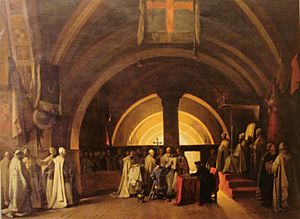
Little is known of his early years, but Jacques de Molay was probably born in Molay, Haute-Saône, in the County of Burgundy, at the time a territory ruled by Otto III as part of the Holy Roman Empire, and in modern times in the area of Franche-Comté, northeastern France. His birth year is not certain, but judging by statements made during the later trials, was probably around 1240–1250.
He was born, as most Templar knights were, into a family of minor or middle-ranking nobility. It is suggested that he was made a knight at age 21 in 1265 and is known that he was about 70 years of age at the time of his execution in 1314. His year of birth is not known and Alain Demurger finds it probable that he was born in the period 1244/45 to 1248/49 or even between 1240 and 1250.
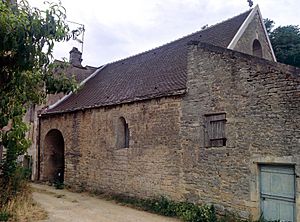
In 1265, as a young man, he was received into the Order of the Templars in a chapel at the Beaune House, by Humbert de Pairaud, the Visitor of France and England. Another prominent Templar in attendance was Amaury de la Roche, Templar Master of the province of France.
Around 1270, de Molay went to the East (Outremer), although little is recorded of his activities for the next twenty years.
Grand master
After the Fall of Acre to the Egyptian Mamluks in 1291, the Franks (a name used in the Levant for Catholic Europeans) who were able to do so retreated to the island of Cyprus. It became the headquarters of the dwindling Kingdom of Jerusalem, and the base of operations for any future military attempts by the Crusaders against the Egyptian Mamluks, who for their part were systematically conquering any last Crusader strongholds on the mainland. Templars in Cyprus included Jacques de Molay and Thibaud Gaudin, their 22nd grand master. During a meeting assembled on the island in the autumn of 1291, Molay spoke of reforming the Order and put himself forward as an alternative to the current grand master. Gaudin died around 1292 and, as there were no other serious contenders for the role at the time, Molay was soon elected.
In spring 1293, he began a tour of the West to try to muster more support for a reconquest of the Holy Land. Developing relationships with European leaders such as Pope Boniface VIII, Edward I of England, James I of Aragon and Charles II of Naples, Molay's immediate goals were to strengthen the defence of Cyprus and rebuild the Templar forces. From his travels, he was able to secure authorization from some monarchs for the export of supplies to Cyprus, but could obtain no firm commitment for a new Crusade. There was talk of merging the Templars with one of the other military orders, the Knights Hospitaller. The grand masters of both orders opposed such a merger, but pressure increased from the Papacy.
It is known that Molay held two general meetings of his order in southern France, at Montpellier in 1293 and at Arles in 1296, where he tried to make reforms. In the autumn of 1296, Molay was back in Cyprus to defend his Order against the interests of Henry II of Cyprus, which conflict had its roots back in the days of Guillaume de Beaujeu.
From 1299 to 1303, Molay was engaged in planning and executing a new attack against the Mamluks. The plan was to coordinate actions between the Christian military orders, the King of Cyprus, the nobility of Cyprus, the forces of Cilician Armenia, and a new potential ally, the Mongols of the Ilkhanate (Persia), to oppose the Egyptian Mamluks and take back the coastal city of Tortosa in Syria.
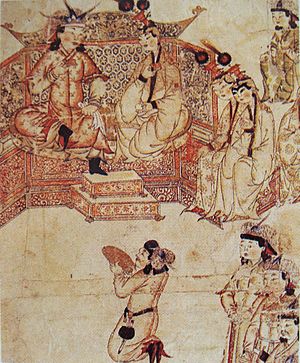
For generations, there had been communications between the Mongols and Europeans towards the possibility of forging a Franco-Mongol alliance against the Mamluks, but without success. The Mongols had been repeatedly attempting to conquer Syria themselves, each time either being forced back by the Egyptian Mamluks or having to retreat because of a civil war within the Mongol Empire, such as having to defend from attacks from the Mongol Golden Horde to the north. In 1299, the Ilkhanate again attempted to conquer Syria, having some preliminary success against the Mamluks in the Battle of Wadi al-Khazandar in December 1299.
In 1300, Molay and other forces from Cyprus put together a small fleet of sixteen ships which committed raids along the Egyptian and Syrian coasts. The force was commanded by King Henry II of Jerusalem, the king of Cyprus, accompanied by his brother, Amalric, Lord of Tyre, and the heads of the military orders, with the ambassador of the Mongol leader Ghazan also in attendance. The ships left Famagusta on 20 July 1300, and under the leadership of Admiral Baudouin de Picquigny, raided the coasts of Egypt and Syria: Rosetta, Alexandria, Acre, Tortosa and Maraclea, before returning to Cyprus.
The Cypriots then prepared for an attack on Tortosa in late 1300, sending a joint force to a staging area on the island of Ruad, from which raids were launched on the mainland. The intent was to establish a Templar bridgehead to await assistance from Ghazan's Mongols, but the Mongols failed to appear in 1300. The same happened in 1301 and 1302, and the island was finally lost in the Siege of Ruad on 26 September 1302, eliminating the Crusaders' last foothold near the mainland.
Following the loss of Ruad, Molay abandoned the tactic of small advance forces, and instead put his energies into trying to raise support for a new major Crusade, as well as strengthening Templar authority in Cyprus. When a power struggle erupted between King Henry II and his brother Amalric, the Templars supported Amalric, who took the crown and had his brother exiled in 1306. Meanwhile, pressure increased in Europe that the Templars should be merged with the other military orders, perhaps all placed under the authority of one king, and that individual should become the new King of Jerusalem when it was conquered.
Travel to France
In 1305, the newly elected Pope Clement V asked the leaders of the military orders for their opinions concerning a new crusade and the merging of their orders. Molay was asked to write memoranda on each of the issues, which he did during the summer of 1306. Molay was opposed to the merger, believing instead that having separate military orders was a stronger position, as the missions of each order were somewhat different. He was also of the belief that if there were to be a new crusade, it needed to be a large one, as the smaller attempts were not effective.
On 6 June 1306, the leaders of both the Templars and the Hospitallers were officially asked to come to the Papal offices in Poitiers to discuss these matters, with the date of the meeting scheduled as All Saints Day (1 November) in 1306, though it later had to be postponed due to the Pope's illness with gastro-enteritis. Molay left Cyprus on 15 October 1306, arriving in France in late 1306 or early 1307; however, the meeting was again delayed until late May due to the Pope's illness.
King Philip IV of France, deeply in debt to the Templars, was in favor of merging the Orders under his own command, thereby making himself Rex Bellator, or War King. Molay, however, rejected the idea. Philip was already at odds with the papacy, trying to tax the clergy, and had been attempting to assert his own authority as higher than that of the Pope. For this, one of Clement's predecessors, Pope Boniface VIII, had attempted to have Philip excommunicated, but Philip then had Boniface abducted and charged with heresy. The elderly Boniface was rescued, but then died of shock shortly thereafter. His successor Pope Benedict XI did not last long, dying in less than a year, possibly poisoned via Philip's councillor Guillaume de Nogaret. It took a year to choose the next Pope, the Frenchman Clement V, who was also under strong pressure to bend to Philip's will. Clement moved the Papacy from Italy to Poitiers, France, where Philip continued to assert more dominance over the Papacy and the Templars.
The Grand Master of the Hospitallers, Fulk de Villaret, was also delayed in his travel to France, as he was engaged with a battle at Rhodes. He did not arrive until late summer, so while waiting for his arrival, Molay met the Pope to discuss other matters, one of which was the charges by one or more ousted Templars who had made accusations of impropriety in the Templars' initiation ceremony. Molay had already spoken with the king in Paris on 24 June 1307 about the accusations against his order and was partially reassured. Returning to Poitiers, Molay asked the Pope to set up an inquiry to quickly clear the Order of the rumours and accusations surrounding it, and the Pope convened an inquiry on 24 August 1307.
Arrest and charges
There were five initial charges lodged against the Templars.
Philip wanted the Templars arrested and their possessions confiscated to incorporate their wealth into the Royal Treasury and to be free of the enormous debt he owed the Templar Order. On 14 September, Philip took advantage of the rumors and inquiry to begin his move against the Templars, sending out a secret order to his agents in all parts of France to implement a mass arrest of all Templars at dawn on 13 October. Molay was in Paris on 12 October, where he was a pallbearer at the funeral of Catherine of Courtenay, wife of Count Charles of Valois, and sister-in-law of King Philip. In a dawn raid on Friday, 13 October 1307, Molay and all the Templars of the central house of Paris were arrested. Philip then had the Templars charged with heresy and many other trumped-up charges, most of which were identical to the charges which had previously been leveled by Philip's agents against Pope Boniface VIII.
Nogaret's captious interrogatories necessarily disconcerted Molai, who, knowing neither law nor theology, was unable to defend himself. During forced interrogation by royal agents at the University of Paris on 24, and 25 October, Molay confessed that the Templar initiation ritual included "denying Christ and trampling on the Cross". He was also forced to write a letter asking every Templar to admit to these acts. Under pressure from Philip IV, Pope Clement V ordered the arrest of all the Templars throughout Christendom.
The pope still wanted to hear Molay's side of the story, and dispatched two cardinals to Paris in December 1307. In front of the cardinals, Molay retracted his earlier confessions. A power struggle ensued between the king and the pope, which was settled in August 1308 when they agreed to split the convictions. Through the papal bull Faciens misericordiam, the procedure to prosecute the Templars was set out on a duality, whereby one commission would judge individuals of the Order and a different commission would judge the Order as a whole. Pope Clement called for an ecumenical council to meet in Vienne in 1310 to decide the future of the Templars. In the meantime, the Order's dignitaries, among them Molay, were to be judged by the pope.
In the royal palace at Chinon, Molay was again questioned by the cardinals, but this time with royal agents present, and he returned to his forced admissions made in 1307. In November 1309, the Papal Commission for the Kingdom of France began its own hearings, during which Molay again recanted, stating that he did not acknowledge the accusations brought against his order.
Any further opposition by the Templars was effectively broken when Philip used the previously forced confessions to sentence 54 Templars to be burnt at the stake between 10 May and 12 May 1310.
The council which had been called by the Pope for 1310 was delayed for a further two years due to the length of the trials, but was finally convened in 1312. On 22 March 1312, at the Council of Vienne, the Order of the Knights Templar was abolished by papal decree.
Death
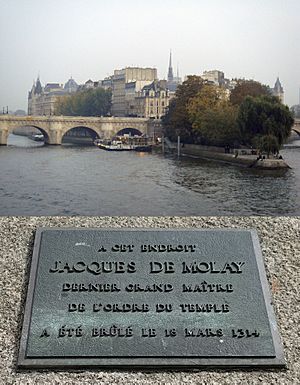
Molay was sentenced to death together with Geoffroi de Charney in 1314 as a direct result of cardinal legates' decisions and actions rather than being ordered by King Philip the Fair. He was burned at the stake on the Ile des Javiaux in the Seine. The most probable date of the execution was according to Alain Demurger and others 11 March 1314 although it is also quoted as 18 March 1314.
Chinon Parchment
In September 2001, Barbara Frale found a copy of the Chinon Parchment in the Vatican Secret Archives, a document which explicitly confirms that in 1308 Pope Clement V absolved Jacques de Molay and other leaders of the Order including Geoffroi de Charney and Hugues de Pairaud. She published her findings in the Journal of Medieval History in 2004. Another Chinon parchment dated 20 August 1308 addressed to Philip IV of France, well known to historians, stated that absolution had been granted to all those Templars that had confessed to heresy "and restored them to the Sacraments and to the unity of the Church".
See also
 In Spanish: Jacques de Molay para niños
In Spanish: Jacques de Molay para niños


